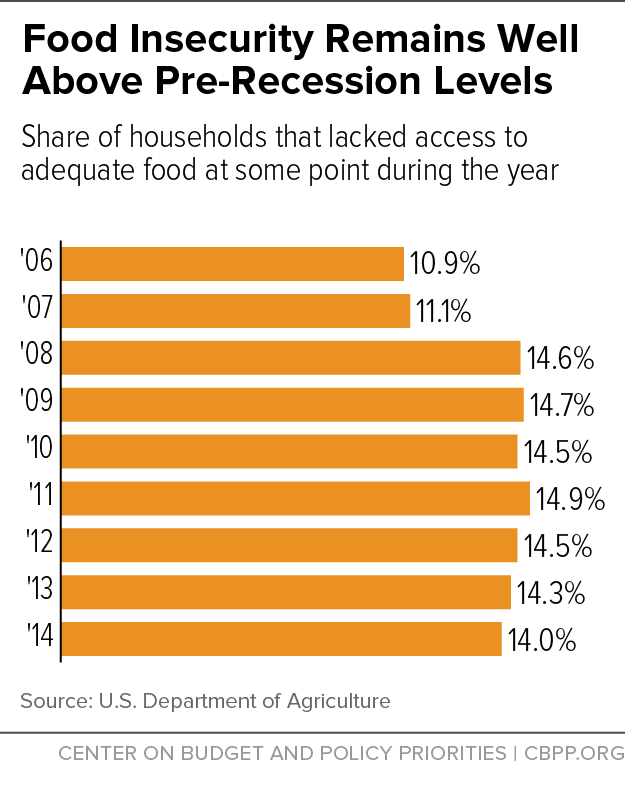BEYOND THE NUMBERS
An estimated 17.4 million households with 48.1 million people were “food insecure” in 2014, meaning they had difficulty affording adequate food at some point in the year, the Agriculture Department (USDA) announced today. At 14 percent, the food insecurity rate is not statistically different from 2013. Though the rate has fallen since 2011, it remains well above pre-recession levels (see graph).
The report also shows:
-
Some 15 million children lived in food-insecure households in 2014. While adults often shield children from food insecurity, about 7.9 million children lived in households where at least one child experienced food insecurity at some point in the year.
-
Over the three-year period of 2012-2014, 14 states had food insecurity rates higher than the U.S. average of 14.3 percent; they include Mississippi (22 percent), Arkansas (19.9 percent), Kentucky (17.5 percent), Texas (17.2 percent), and Ohio (16.9 percent). (The report uses three-year averages due to small sample sizes.) Twenty states had rates below the U.S. average, including North Dakota (8.4 percent), Massachusetts (9.6 percent), New Hampshire (10 percent), Virginia (10.1 percent), and Minnesota (10.4 percent).
-
An estimated 17.2 million Americans lived in households where members experienced “very low food security” last year, meaning that, for instance, they had to skip meals or eat less because they lacked money for food at some point in the year. The very low food security rate among households remained unchanged from 2013, at 5.6 percent.
The new figures show that millions of Americans are struggling, despite signs that the economic recovery is reaching more households. Wage growth remains slow. Food banks are seeing increased demand this year and expect to distribute more food in 2015 than in 2014 or 2013, the Associated Press reported recently.
Given that food insecurity remains high, it’s no surprise that participation in SNAP — which helps millions of Americans afford adequate food — is also above pre-recession levels, though it’s fallen over the last two years. SNAP expands during economic downturns as more people become eligible and then contracts as the economy strengthens.
Food insecurity will likely rise significantly in 2016 among able-bodied adults without dependents, roughly 1 million of whom risk losing SNAP as a time limit now waived due to high unemployment returns in most states. These individuals will lose benefits after three months if they aren’t working 20 hours a week or participating in a work program, even if they are looking for work. The loss of this crucial food assistance will likely make it harder for many of these individuals — many of whom are extremely poor and receive little if any other assistance — to afford food.

